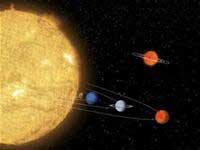 Astronomers have recently discovered what they believe is the impending birth of the smallest solar system: through astronomical observations from both ground-based and space telescopes, they have uncovered a brown dwarf, less than 1% the mass of the Sun, surrounded by a disk of dust and gas.
Astronomers have recently discovered what they believe is the impending birth of the smallest solar system: through astronomical observations from both ground-based and space telescopes, they have uncovered a brown dwarf, less than 1% the mass of the Sun, surrounded by a disk of dust and gas.
Kevin Luhman, from Pennsylvania State University and the lead scientist of the team that announced this discovery, stated that this small brown dwarf, located approximately 500 light-years away in the constellation Chamaeleon, is in the process of forming a planet and could one day evolve into a solar system.
For a long time, many believed that our solar system formed when a massive cloud of dust and gas collapsed to create the Sun and planets around 4.5 billion years ago. This new discovery is noted for its characteristics of planetary formation. If this dust disk successfully forms a planet, a new solar system will emerge that is about 100 times smaller than our own solar system.
This brown dwarf is larger than a planet but smaller than a star, believed to be remnants of gas that have gathered enough mass to potentially form a bright star. It has been recorded through NASA’s Spitzer and Hubble space telescopes, as well as through ground-based observations.
T.VY




















































